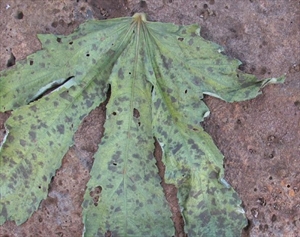Leaf mould, leaf blotch
Pacific Pests, Pathogens, Weeds & Pesticides - Online edition
Pacific Pests, Pathogens, Weeds & Pesticides
Bele (Abelmoschus) leaf blotch (322)
Pseudocercospora abelmoschi; previously Cercospora abelmoschi, Oidium abelmoschi.
Asia, Africa, North, South and Central America, the Caribbean, Oceania. Recorded from American Samoa, Australia, Fiji, Palau, Samoa, Solomon Islands, Tonga, and Vanuatu.
Bele (aibika, sliperi kabis, island cabbage), Abelmoschus manihot. Also recorded on okra (Abelmoschus esculentus).
Leaf spots are circular to irregular, often limited by the veins, brown with a blackish brown margin on the upper leaf surface (Photo 1), and pale brown mould on the underside (Photo 2). Often, spots do not develop, instead there are sooty, olive–brown to blackish-brown indistinct angular leaf blotches (Photo 3). Spores develop predominantly on the lower leaf surface; the patches with spores may join together so that fungal growth covers the whole leaf (Photo 2&4). Severely affected leaves may become chlorotic, rolled, wilted, and fall to the ground.
Spread is by spores blown in the wind. Survival is in crop debris.
The disease is only of minor importance. It is mostly on older leaves and so it is likely that the impact on bele is minimal as it is the young leaves that are used as a greens. However, on okra the disease may have greater impact. It is said to be serious in Bangladesh where the use of fungicides is said to be needed to bring about control.
Look for the pale brown spots with distinct margins on the older leaves on the upper surface (bele), or dark indistinct patches (okra). Look at the underside of the leaf to see blackish-brown fungal growth, sometimes covering the whole leaf.
CULTURAL CONTROL
Before planting:
- Do not plant new crops next to those that are infected: spores blowing from existing infected plants are a major source of infection.
During growth:
- Remove older infected leaves, and burn them, when harvesting young leaves (bele) or fruit (okra) for consumption.
After harvest:
- Collect and burn or bury as much of the crop as possible after final harvests.
- Do not plant crops of bele or okra one after another in the same land; use a rotation of at least 2 years, rotating with other types of vegetables.
CHEMICAL CONTROL
If blemish-free leaves are required, use copper fungicides or mancozeb.
____________________
When using a pesticide, always wear protective clothing and follow the instructions on the product label, such as dosage, timing of application, and pre-harvest interval. Recommendations will vary with the crop and system of cultivation. Expert advice on the most appropriate pesticides to use should always be sought from local agricultural authorities.
AUTHORS Grahame Jackson & Eric McKenzie
Information from Pseudocercospora abelmoschi. Editor Bob Macfarlane. Ecoport: (http://ecoport.org/ep?Fungus=23085&entityType=FU****&entityDisplayCategory=full); and from (including Photos 1,2&4) McKenzie E (2013) Pseudocercospora abelmoschi: PaDIL - (http://www.padil.gov.au).
Produced with support from the Australian Centre for International Agricultural Research under project PC/2010/090: Strengthening integrated crop management research in the Pacific Islands in support of sustainable intensification of high-value crop production, implemented by the University of Queensland and the Secretariat of the Pacific Community.







